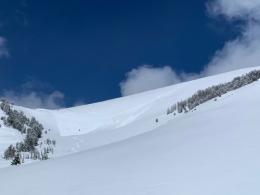Good morning. This is Dave Zinn with the Gallatin National Forest Avalanche Forecast on Tuesday, March 28th at 7:00 a.m. This information is sponsored by Highline Partners and World Boards. This forecast does not apply to operating ski areas.
This morning, temperatures are in the single digits to teens F with 10-15 mph winds from the west to the south. Excepting Cooke City, the mountains received 1-2” of snow yesterday morning before this weekend’s storm exited the area. Today, temperatures will climb into the 20s to around 30 F with 10-15 mph wind from the southwest. A trace to 1” of snow is possible tonight.
It is possible to trigger avalanches in recently wind-drifted snow and on deeply buried persistent weak layers in the mountains around Bozeman, Big Sky and West Yellowstone. The winds increased to 10-20 mph yesterday afternoon for the first time since 14-32” of snow fell this weekend, transporting snow onto slopes where avalanches are the most likely today. Increasing cloud cover will minimize wet snow danger but shift to cooler aspects if the snow surface gets wet this afternoon.
A skier outside the boundary of Big Sky Resort triggered a fresh drift of snow from 75’ away that broke an estimated 1-2’ deep and 75’ wide. He felt “lucky” to have not had the carpet ripped out from under him (details and photo). Riders and skiers in the Bridger Range reported a natural avalanche that failed yesterday (details and photo) and two avalanches that failed on the Throne during the storm (details and photo). Review the avalanche activity log for information about all the recent slides, including a small avalanche that partially buried a skier or rider on Little Ellis south of Bozeman (photos and details).
While this weekend’s avalanche activity involved new and wind-drifted snow, less than a week ago, a slide broke 8-10 ft deep in Hyalite Canyon (details and photos). Our recent videos highlight this concern and how it affects our decision-making.
Eliminate the risk of getting caught in an avalanche by staying off and out-from-under terrain steeper than 30 degrees or reduce the chances of triggering a slide by selecting non-wind-loaded slopes and assessing for obvious instability in the upper few feet of the snowpack. The avalanche danger is MODERATE.
The primary avalanche concern around Cooke City is triggering an avalanche on deeply buried weak layers. Most recently, two riders were caught and one was seriously injured by a slide that broke 4 feet deep on Henderson Mountain last Thursday (details and photos, video). Riding for the last two days in the area, we observed several snowdrifts near ridgelines that broke and avalanched. While wind-drifted snow is a concern in steep terrain, the potential for deep slab avalanches drives our decision-making. Terrain selection and avalanche avoidance is the key. In my videos from Cooke City, I discuss selecting non-wind-loaded terrain and slopes that minimize the chances of getting caught and reducing the consequences of a mistake by limiting exposure to terrain traps like gullies, trees, cliffs and rocks (video1, video2).
Human-triggered avalanches are possible, and the avalanche danger is MODERATE.
Please share avalanche, snowpack or weather observations via our website, email (mtavalanche@gmail.com), phone (406-587-6984), or Instagram (#gnfacobs).
Triggering an avalanche in the recent snow and wind-drifted snow is possible on steep slopes in the Centennial Mountains. Avalanches can also break several feet deep on buried weak layers. Eliminate the risk of getting caught in an avalanche by staying off and out-from-under terrain steeper than 30 degrees or reduce the chances of triggering a slide by selecting non-wind-loaded slopes and assessing the snowpack for instability before considering steep slopes.
Upcoming Avalanche Education and Events
Events and Education Calendar.
Loss in the Outdoors is a support group for those affected by grief and loss related to outdoor pursuits. Check out the link for more information.
Avalanches have killed 21 people in the United States so far this season. On Wednesday, March 22nd, a snowmobiler was killed in an avalanche in central Idaho. This was the eighth fatality in March.
More info on each event is available at the Avalanche.org Accidents Page.



